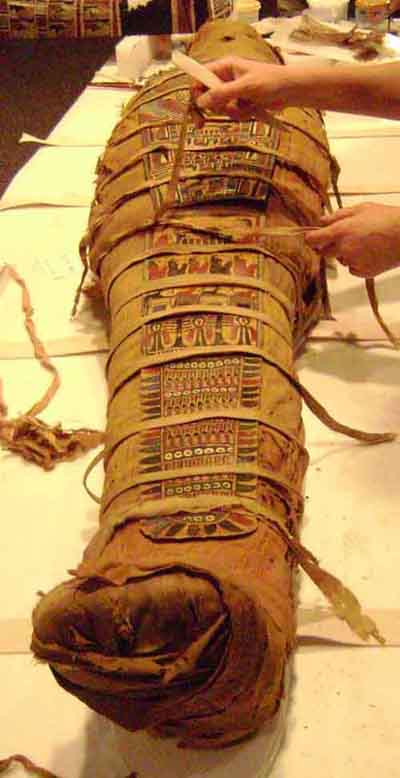Mummies

The word 'mummy' is not of Egyptian origin, but is derived from the Arabic 'mumiyah,' which means 'body preserved by wax or bitumen'; This term was used because of an Arab misconception of the methods used by the Egyptians in preserving their dead.
A mummy is a corpse whose skin and flesh have been preserved by either intentional or incidental exposure to chemicals, extreme cold, very low humidity, or lack of air when bodies are submerged in bogs.
Mummies of humans and other animals have been found throughout the world, both as a result of natural preservation through unusual conditions, and as cultural artifacts to preserve the dead.
The best known mummies are those that have been deliberately embalmed with the specific purpose of preservation, particularly those in ancient Egypt, where not only humans but also crocodiles and cats were mummified.
Ancient Greek historians record that the Persians sometimes mummified their kings and nobility in wax, though this practice has never been documented in Egypt.
The body of a Persian Princess which surfaced in 2004 in Pakistans mummy had a nature which turned out to have been forged.
In China, preserved corpses have been recovered from submerged cypress coffins packed with medicinal herbs.
Although Egyptian mummies are the most famous, the oldest mummies recorded are the Chinchorro mummies from northern Chile and southern Peru.
Also among the oldest is Uan Muhuggiag which is a place in the central Sahara, and the name of the mummy of a small boy found there in 1958 by Professor Fabrizio Mori. The mummy displays a highly sophisticated mummification technique, and at around 5,500 years old is older than any comparable Ancient Egyptian mummy.
The monks of Palermo in Sicily began mummifying their dead in 1599, and gradually other members of the community wished to have their bodies preserved as a status symbol. The last person to be mummified there died in the 1920s. The Capuchin catacombs of Palermo contain thousands of bodies, many which are clothed and standing, however in many cases the preservation was not successful with only the skeleton and clothing surviving.
Many ancient civilizations believed in life after death, mummifying those who had died to guarantee the soul passage into the next life. Different civilizations had their own rituals to that end. Some believed that the dead lived on in the tomb, while others thought of the dead as having gone to a blessed afterworld in some far-distant place. That being the case they provided for both worlds, elaborate preparations for the afterlife been made in the preservation of the dead.
No comments:
Post a Comment